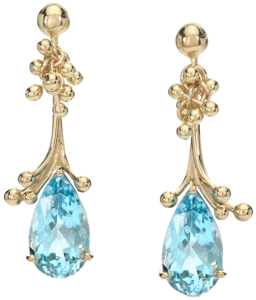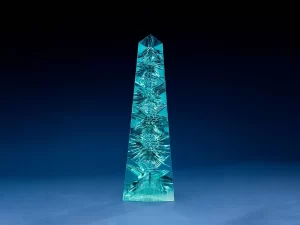 Introduction:
Introduction:
Its title, “Aquamarine,” derives from the Latin words “aqua,” meaning water, and “marina,” meaning sea. Similar to emeralds, aquamarine belongs to the beryl group
History:
Roman fishermen referred to this gemstone as the “water of the sea,” utilizing it for protection and ensuring safe voyages by boat, as well as for luck in their fishing endeavors. The allure of aquamarine extended to ancient civiliztions such as the Sumerians, Egyptians, Hebrews, and Greeks. Evidence of its admiration includes aquamarine beads found with Egyptian mummies and beliefs that the High Priest of the Second Temple wore aquamarine stones engraved with the six tribes of Israel. In ancient Greece, intricate designs were engraved into aquamarine stones, transforming them into exquisite intaglios.
 Origin:
Origin:
Aquamarine forms in pegmatite veins within metamorphic and igneous rocks. These rocks undergo intense heat and pressure, allowing beryl to crystallize into aquamarine. Brazil’s aquamrine originates from pegmatite formations in granite. Deposits in Nigeria and Zambia are associated with metamorphic rocks. Aquamarine in Madagascar is found in pegmatites within metamorphic terrains. Pakistan’s aquamarine is sourced from pegmatites in granitic rocks. Mozambique’s aquamarine forms in pegmatites within metamorphic rocks.
 Color:
Color:
While personal preference plays a role, deeper hues of blue or blue-green are generally considered more valuable than lighter shades. Choose a color that resonates with you while bearing in mind the gem’s overall value.
 Clarity:
Clarity:
Most cut aquamarines exhibit minimal to no visible inclusions, contributing to their beauty. However, rarer and more expensive specimens may be entirely free of visible flaws. Assess the clarity of the gemstone to ensure it meets your standards.
The Dom Pedro Aquamarine stands as a majestic testament to the Earth’s hidden treasures. A 100-pound crystal unearthed in the late 1980s, now transformed into a dazzling gemstone weighing approximately 4.6 pounds, is one of the world’s largest and most remarkable aquamarines.
 Treatments & Synthetics:
Treatments & Synthetics:
Aquamarine can be synthesized using hydrothermal methods to replicate natural formation conditions, producing gem-quality stones. Common treatments include heat treatment to enhance color and clarity, a widely accepted practice in the gemstone industry. Irradiation is sometimes used to create blue colors or intensify existing ones. Buyers should inquire about treatment disclosures when purchasing aquamarine jewelry iridescence.
 Markets & Trends:
Markets & Trends:
Aquamarine continues to be a sought-after gemstone in the jewelry market. Trend-wise, there’s a growing interest in ethically sourced and sustainable aquamarine. Designers are incorporating aquamarine into contemporary and minimalist jewelry pieces, appealing to a wide range of consumers. The market also sees a rise in customized aquamarine jewelry, reflecting individual tastes and preferences.

Elevate Your Knowledge with IIG Online and Offline Programs.
Visit the fastest-growing premier education institute of the Gems and Jewellery Industry at our locations at Mumbai – Opera House & Andheri (East), Bengaluru, Kolkata and Surat. We are easily accessible on Instagram, Facebook, LinkedIn and Twitter @iigofficial
Feel free to write to me if any query regarding career guidance for Gems & Jewellery industry: rahul@iigindia.com
To learn more about Aquamarine and other popular gemstones visit us www.iigindia.com/blogs


